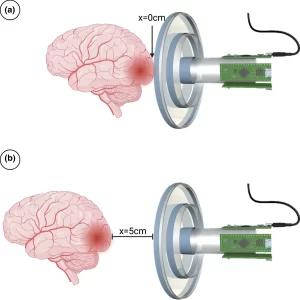“Revolutionizing Stroke Diagnosis: The Integration of Smart Textiles with Eddy Current Damping Sensors for Rapid, Noninvasive Medical Imaging”
Hey there, textile tech enthusiasts! Today, we are delving into an intriguing frontier where traditional textiles meet groundbreaking tech to potentially revolutionize medical diagnostics. Imagine a fabric that doesn’t just adorn you but actively contributes to saving lives. Enter the realm of smart textiles, more specifically, a novel noninvasive transcranial stroke detection method using an Eddy Current Damping (ECD) sensor. While this article published in *Scientific Reports* delves deep into the technical intricacies, we’ll untangle the complex threads and weave a captivating tale of innovative textile technology that could change stroke diagnosis forever.

The Stroke Dilemma: Time is Brain
Strokes, which are brain attacks caused by interrupted blood flow, can be classified into ischemic (blockage of blood vessels) and hemorrhagic (bleeding in the brain). Accurate and rapid differentiation is crucial because treatments vary dramatically. Missed or delayed diagnosis often results in worsening neurological functions and even death. Conventionally, stroke diagnosis hinges on computed tomography (CT) scans, which aren’t always immediately available, especially in emergency settings, rural areas, or low-resource regions. This delay is critical because, in stroke treatment, time truly is brain—every second counts.
Enter the Eddy Current Damping Sensor: Textiles Get Smart
The ECD sensor is a game-changer, offering a much-needed solution for rapid, bedside stroke diagnosis and classification. Imagine a portable device so intuitive and accessible that it can be woven into a medical cap, ready for emergency use. This smart textile can differentiate between ischemic and hemorrhagic strokes by measuring variations in electrical conductivity within the brain.
To put it simply, the brain’s various tissues and fluids, from myelin-rich regions to blood, conduct electricity differently. The ECD sensor leverages these conductivity distinctions. When placed against the head, the sensor induces tiny electrical currents (Eddy currents) in the brain. These currents, in the presence of hemorrhage or ischemia, alter the resonant frequency and resistance of the sensor coil. By analyzing these changes, the sensor generates a real-time map of brain conductivity, pinpointing the type and location of the stroke.
Fabricating the Tech: Building the Smart Coils
The construction of the ECD sensor involves crafting solenoid coils of different sizes using Litz wire, known for its efficiency in carrying alternating currents. The coils created ranged in diameter from 1.5 cm to 11.4 cm, each tailored for various depths of brain scanning. These coils were then connected to an inductance-to-digital converter chip, converting signals into readable data displayed on a laptop. This setup essentially transforms advanced electronics into a deployable textile, ready to be incorporated into medical fabrics.
But it doesn’t stop there. The science behind this involves sophisticated computational models. Using COMSOL Multiphysics software, simulations of the human head with induced lesions provided insights into magnetic field distribution and scanning accuracy. Experimental results with human participants validated these models, showing promise for this method’s real-world application.
Clinical Testing: Proof of Concept
In a clinical setting, the ECD sensor was tested on eight participants, including stroke patients and healthy controls. A custom-made head cap, fitted with the sensor, was placed on each participant, and scans were conducted at their bedsides. Within 15 minutes, the device successfully differentiated between ischemic and hemorrhagic strokes and matched CT scan results with remarkable accuracy. For example, a 32-year-old woman presenting with a hemorrhagic stroke showed congruent results from both the CT scan and the smart textile sensor, illustrating the sensor’s capacity to detect bleeding accurately.
Tuning the Fabric-Sensor: Customizing Detection
One of the textile sensor’s breakthroughs is its tunability. By adjusting coil sizes and the number of turns, the range and sensitivity of the sensor can be customized. Larger coils scan deeper and over broader areas, making them ideal for locating substantial hemorrhages, while smaller coils provide high accuracy for localized, shallower scans. This tunable aspect is akin to weaving specificity into the fabric, where each thread contributes to overall precision.
Beyond Stroke: Implications for Rural and Global Health
While the immediate application of this smart textile sensor is in stroke diagnosis, its implications stretch far wider. Rural areas and developing countries often lack access to advanced medical imaging technologies. This portable, cost-effective, and easy-to-use sensor could democratize medical diagnostics, ensuring that timely and accurate diagnosis isn’t a privilege limited to the wealthy or urban populations. For example, with stroke morbidity rates surpassing those in the US tenfold in some second and third-world countries, this technology could be a literal lifesaver.
Moreover, the sensor’s low power consumption and non-reliance on ionizing radiation make it safer and more sustainable compared to traditional imaging technologies. This facet also aligns with the broader vision of integrating tech within textiles to create reusable, sustainable medical solutions.
Future Fabrications: Enhancing Capabilities Through AI
Imagine a future where these smart textiles don’t just detect strokes but also integrate machine learning algorithms to enhance diagnostic capabilities. Real-time data processing and pattern recognition could refine the sensor’s accuracy, making it possible to detect even sub-millimeter lesions or early-stage strokes. These enhancements could enable first responders and clinicians to make informed decisions swiftly, reducing response times and improving patient outcomes dramatically.
In the grand tapestry of healthcare, integrating advanced tech within textiles stands as a testament to human ingenuity and the limitless possibilities at the intersection of fabric and function. The journey from concept to clinic showcases a seamless blend of engineering, medical science, and textile technology, weaving a narrative of innovation that offers hope and efficiency in critical care scenarios.
As we continue to explore and refine these smart textiles, the future of medical diagnostics looks promisingly tailored to meet the urgent demands of health crises, ensuring that care is accessible, efficient, and equitable for all. So, next time you think of textiles, remember—they might just save your life.
Keywords: Smart Textiles, Eddy Current Damping (ECD) Sensor, Stroke Diagnosis, (Post number: 101), Conductivity Measurement, Medical Innovation





